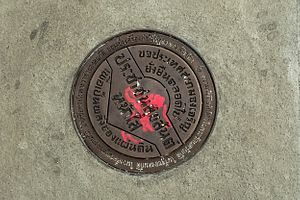Thais who still believe in democracy don’t have much to cling to these days. The country is in its third year of military rule, basic rights have been eroded, and a long-promised election seems to be disappearing further into the horizon. When civilian rule does return, it will be curtailed by a new constitution that weakens parliament, creates a fully appointed senate, and gives the military continued influence in political affairs. With the future so bleak, activists looked to the past for inspiration, adopting a historic plaque in the capital as a symbol of their struggle for democracy. Now this, too, has been taken away.
The plaque, commemorating Siam’s 1932 revolution against the absolute monarchy, has been embedded in the road at the Royal Plaza for around 80 years, but recently vanished under mysterious circumstances. In its place lies a new marker that makes no mention of either the revolution or Thailand’s first constitution. Instead, the replacement bears an inscription calling for loyalty to the king and country.
The governing junta has denied responsibility and claims to be investigating the incident. However, coup leader-turned-Prime Minister Prayut Chan-o-cha said the plaque’s disappearance was “not a matter of life and death” and urged people to think about the future instead of the past.
“Old subjects are just history,” he told the press, before warning against protests over the missing plaque. Gatherings of more than five people have been banned since the military seized power.
For more than a decade, Thailand has been beset by a bitter political crisis that, in many ways, can be traced back to the revolution of June 24, 1932. The ease with which a small group of military officers and civil servants overthrew the absolute monarchy that day obscured the momentous change that had taken place, and gave no indication of the 80-year power struggle that would follow as a result.
Rather than abolish the monarchy altogether, the revolutionary Khana Ratsadon, or People’s Party, sought to constrain it by placing it under a constitution. Unsatisfied with the new arrangement, the royalists fought to reassert their influence, which they gradually did over the next few decades by making shrewd alliances with the military and middle classes. By the mid-20th century, the power of the Khana Ratsadon had waned and the royalists were ascendant. In the decades that followed, authoritarian and semi-authoritarian governments ran the country under the official ideology of “Nation, Religion and King,” with those closest to the palace commanding considerable power and influence.
However, growing demands from a broadening electorate empowered a new breed of politicians, whose rise challenged the traditional elites. The brash but popular Prime Minister Thaksin Shinawatra was seen as a particular threat, prompting his removal by a military coup in 2006. The ill-advised putsch sent Thailand careening into its current crisis and left society bitterly divided. On one side are those who wish for an elected government, with all institutions — including the military and monarchy — firmly bound by a constitution. On the other are the royalists, who put the monarchy at the center of all aspects of Thai life, distrust elected politicians and prefer the country be administered by bureaucrats.
The plaque perfectly embodies this rift. For progressive Thais, it is a symbol of dashed hopes; a reminder of the nascent democracy that was so prematurely aborted but may one day return. For the royalists, it is an affront to their beloved monarchy and feeds into deep anxieties over the future of the institution.
Contention surrounding the plaque is not new. It was previously removed during the dictatorship of Field Marshal Sarit Thanarat, a staunch traditionalist whose rule from 1959-1963 is considered one of Thailand’s most repressive. More recently, after becoming a symbol for democracy activists, it was badly scratched in acts of vandalism by those who oppose them. The debate intensified after the death of King Bhumibol Adulyadej in October last year, with repeated calls from royalists for it to be removed.
Yet for all the controversy it evokes, the plaque itself is quite insignificant. Measuring only 30 centimeters in diameter, the tiny brass plate lay in the shadow of a huge equestrian statue of King Chulalongkorn, one of the most revered monarchs of the Chakri dynasty. Lost in the vastness of the public square leading up to the ornate Throne Hall, cars would frequently drive over it with no regard. By all accounts, many Thais were not even aware of its existence.
However, its symbolism is substantial. For royalists, the revolution of 1932 is a blight on an otherwise glorious history and the plaque, implanted in the most royal of spaces, an indignity. But their disquiet may go deeper than that; the Thai word for the plaque is mut, literally meaning “knot” or “pin,” which leads distinguished historian, Charnvit Kasetsiri to posit a supernatural significance. It could be, he told Thai media, that the superstitious believe royal power was being “tied” or “pinned down” by the plaque.
The removal of the plaque is a shameful attempt to erase history and assert royalist dominance over a democracy that is already on its knees. However, it may also be backfiring; since the incident occurred, the previously obscure memorial has been splashed all over the media, the story is trending online and Thais are suddenly talking about 1932 again. One bookshop even advertised a special discount on books about the revolution, with a copy of the first constitution thrown in for free. Instead of burying history, the royalists might just have dug it up and given it new life again.
The democracy movement in Thailand has been flagging recently; weary and dejected after a decade of setbacks. The plaque’s removal may well have given them new energy — and something to rally around.
James Buchanan is a Senior Research Associate and PhD Candidate at the Department of Asian and International Studies, City University of Hong Kong.

































